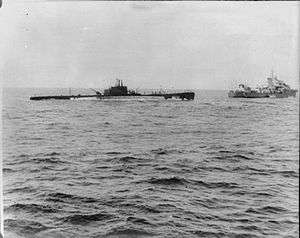HMS X2
 The Galileo Galilei being taken under tow by HMS Kandahar | |
| History | |
|---|---|
| Name: | Galileo Galilei |
| Namesake: | Galileo Galilei |
| Builder: | Tosi (Taranto, Italy) |
| Laid down: | 15 Oct 1931 |
| Launched: | 19 March 1934 |
| Captured: | by the Royal Navy, 18 June 1940 |
| Name: | HMS X-2, later P771 |
| Acquired: | June 1940 |
| Commissioned: | June 1942 |
| Fate: | Scrapped, January 1946 |
| General characteristics | |
| Class and type: | Archimede |
| Displacement: | 880 tons surfaced, 1230 tons submerged |
| Length: | 70.5 m |
| Beam: | 6.87 m |
| Draught: | 4.12 m |
| Propulsion: | 2 x Tosi Diesel engines; 2 x Marelli electric motors. |
| Speed: | 17 knots surface, 7.7 knots submerged |
| Range: | 10,500 nmi at 8 knots |
| Complement: | 55 |
| Armament: | 8 Torpedo tubes, 2x 100mm L/43 Deck Gun, 2 x 13.2mm AA guns |
HM Submarine X2 was an Italian Archimede-class submarine, originally named Galileo Galilei. She served in the Regia Marina before and during World War II, before her capture by the Royal Navy in 1940.
She was stationed in the Red Sea in June 1940 as a unit of the Italian Red Sea Flotilla. During a patrol, with Capitano di Corvetta[note 1] Corrado Nardi in command,[1] on 16 June 1940, she sank the Norwegian tanker James Stove approximately 12 miles south of Aden,[2] following which aircraft from the cruiser HMS Leander carried out a search for her without success.
On 18 June, the Galilei halted with cannon fire the Yugoslavian cargo ship Drava, but as Yugoslavia was not yet at war, she let it proceed.[2] The gunfire was heard by the anti-submarine warfare trawler HMS Moonstone and at 4:30pm Moonstone sighted the periscope of Galileo Galilei and carried out an attack with two depth charges, though without damaging the submarine[1][2] at the position 12°48′N 45°12′E / 12.800°N 45.200°E. The following day, after the British warship repeated its attack with depth charges, Nardi gave the order to surface and engaged the Moonstone with her guns.[2] At the start of the action between the two vessels, the forward gun's sighting mechanism on the Galilei became unusable. The fast-moving Moonstone scored the first hit on the Italian boat after ten minutes, killing some men and wounding Nardi.[2] The following hit killed the crew of the forward gun, including the First Officer.[2] The submarine's aft gun jammed, and then another salvo from Moonstone killed all those on the conning tower including Nardi.[2] Under the only officer left alive, though wounded, the young midshipman Mazzucchi, the Galilei continued the fight with the forward gun. However the British destroyer HMS Kandahar arrived,[2] and Galilei surrendered. The submarine had lost 16 men; Nardi, four other officers, seven NCOs and four sailors.[3] The submarine was then towed into Aden. Though the British side claimed that the submarine's codebooks and operational documents were captured intact by the Royal Navy, and revealed the exact position of other Italian naval units, Italian survivors (including Midshipman Mazzucchi) reported that every document was destroyed before surrender, and that no written operational orders were issued to Italian units, only an oral briefing between captains and the submarine command in Massawa before every mission[4] The claim was reported only to cover the British intelligence activities in Italian East Africa.[4]
After her capture, Galileo Galilei was berthed at Port Said and served as a generating station to charge the batteries of British submarines.[5] She was commissioned into the Royal Navy in June 1942 as HMS X2 (later changed to P 711), and was operated as a training boat in the East. She was scrapped on 1 January 1946.
| Patrol | Date | Ship | Flag | Tonnage | Notes |
|---|---|---|---|---|---|
| 1st | 16 June 1940 | James Stove | 8,215 | Tanker; no casualties |
See also
- HMS Graph - another captured submarine (formerly the U-570) commissioned into the Royal Navy
- HMS Seal - Royal Navy submarine, captured and taken into service by the Germans.
- Playfair, Major-General I.S.O.; Molony, Brigadier C.J.C.; with Flynn, Captain F.C. (R.N.) & Gleave, Group Captain T.P. (2009) [1st. pub. HMSO:1954]. Butler, Sir James, ed. The Mediterranean and Middle East, Volume I: The Early Successes Against Italy, to May 1941. History of the Second World War, United Kingdom Military Series. Uckfield, UK: Naval & Military Press. ISBN 1-84574-065-3.
Notes
- Notes
- ↑ the equivalent rank to Lieutenant Commander
- Citations
- 1 2 http://www.xmasgrupsom.com/Sommergibili/galileogalilei.html
- 1 2 3 4 5 6 7 8 "Giorgio Giorgerini, Uomini sul fondo. Storia del sommergibilismo italiano dalle origini a oggi, p. 395-396"
- ↑ http://www.regiamarina.net/sub_casualties.asp?nid=196&lid=2
- 1 2 "Giorgio Giorgerini, Uomini sul fondo. Storia del sommergibilismo italiano dalle origini a oggi, p. da 396 a 399"
- ↑ Playfair, Vol. I, page 112.